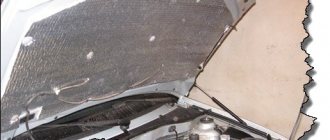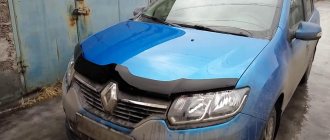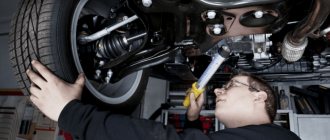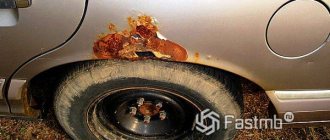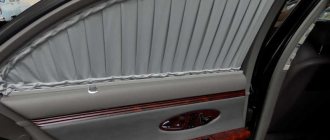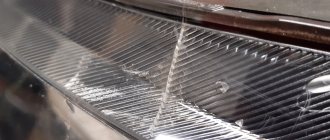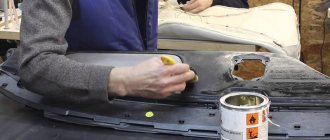If you use your car in winter, then you simply need to insulate the hood. This way, you can save not only time, but also money while the engine is warming up.
Reasons for insulation
First, let's define the reasons for auxiliary insulation of the hood.
- during the frosty period, it is necessary to spend a long time warming up the engine, which is associated with excessive fuel consumption;
- During winter, a layer of ice forms on the hood, which negatively affects the paintwork.
Today, when there is a total shortage of everything everywhere, not every car enthusiast will want to wait for the engine to fully warm up. In addition, to preserve the presentability of the car, not everyone will carry out expensive polishing of the body.
All of the above provides a convincing basis for immediate insulation of the hood.
Material for insulation and clips
Before you start insulating the hood, you need to visit a store where you need to find all the auxiliary tools and material.
The most common material that you can use to insulate the hood is felt. Despite the fact that its appearance is far from ideal, it is inexpensive and does not wear out quickly.
And yet, even despite its low cost, it is very difficult to buy in our time.
Therefore, it is better to choose polypropylene foam, which is covered with foil. You can purchase it at any hardware store.
This material is sold almost everywhere under the Izolon brand and costs about $1.5 per sq.m. It is distinguished by the fact that it does not deform even when heated to 150.0 degrees Celsius.
It is this characteristic that makes it suitable for the task of keeping you warm.
To insulate the hood of a passenger car, it is necessary to form a layer of insulation with a thickness of about 2 centimeters. To do this, you will spend no more than two layers of Isolon.
After the material is selected, it must be strengthened in a certain place. You don't need to be a great technologist to understand that in most cars, fastening can be done using specialized clips.
They can be purchased at any auto parts store.
Hood insulation technology
1. First you need to cut out a pattern for the insulation for the hood. An unclaimed roll of wallpaper after renovation is suitable for this.
2. Then, using clips purchased at an auto parts store, we attach the wallpaper to the hood and draw out a pattern of the required dimensions, simultaneously marking the protrusions for the ribs.
3. Then, using the pattern, cut off the required piece or two from Izolon. Additionally, prepare a piece of Isolon to retain heat in the area of the stiffeners.
4. Glue the cut out parts of the insulation into one whole.
5. Make holes for the clips in the resulting insulation so that they coincide with the holes in the hood. Secure the insulation to the hood with clips and cut off the excess with a knife.
Now the insulated hood of your car will give you the opportunity to travel, despite the harshest winter, and avoid prolonged and thorough warming up of the engine.
And, of course, ice will not appear on the hood. Which is, in general, what we were striving for.
By performing these simple insulation manipulations, you will provide yourself and your car with additional benefits when operating in winter. Article: how to insulate an engine with your own hands.
In winter, during severe frosts, every car owner is faced with the problem of prolonged engine starting. Hood insulation will help partially solve the problem. Thanks to additional thermal insulation, the car will cool down significantly more slowly, which will save on fuel when warming up the car and increase the service life of the engine.
The best materials for hood insulation
According to the laws of physics, everyone knows that heated air rapidly rises, so by installing hood insulation with your own hands, you can prevent rapid cooling of the power unit. Most modern products have a porous structure, due to which heat is retained in the car body for a long time.
Simultaneously with insulation, it is used as hood sound insulation
Few people understand the abundance of offers from insulation manufacturers; it is especially difficult to determine the characteristics of a product by what the material is called or looks like. That is why, before purchasing hood insulation, you should first study its types and features.
Isoflex
The self-adhesive material is based on polyurethane foam filler, which can be covered with PVC, PET, anti-adhesive film, and textiles. The main advantage is the double effect, it helps improve the sound and heat insulation of the car.
The estimated cost is 65-85 rubles/m2. It should also be noted that this option is tightly fixed to the surface of the hood and is fireproof.
Tiviplene
An excellent option for insulation under the hood, which is equipped with an adhesive base on the reverse side. The product consists of polyethylene foam with a petrol-resistant polyethylene terephthalate surface. The thickness of the canvas is 4, 8 or 15 mm, so the product, even without foil, does a good job of retaining heat. Price – more than 230 rubles.
Tiviplen is used for thermal insulation of any car, regardless of modification. The coating does not absorb moisture and does not decompose; it can withstand temperatures from -40°C to +70°C.
Stizol
As it is also called, penofol is made from polyethylene foam and is covered on one or both sides with foil. Even if you cover a car with your own hands with the thinnest coating, the level of heat retention of stizol will be much higher than its analogues, since due to the reflective surface it provides the effect of a thermos.
This material does not accumulate or conduct electricity. It is characterized by increased elasticity, resilience and resistance to mechanical stress. Also, the product is non-flammable, considered moisture-resistant, durable, and environmentally friendly. Pasting the hood with this material with your own hands is not difficult; the sticky layer fixes the product well on a smooth surface.
Splen
Elastic insulation material with adhesive surface and foil coating. The thickness of the canvas is in the range of 3-10 mm.
But here you should take into account that the larger the parameter, the higher the cost, and the price also depends on the number of layers of foil. Prices start at 160 rubles per sheet.
Izolon
The main advantage of this option is its low cost and effective heat retention. The price varies between 50-200 rubles/m2, this indicator is directly influenced by the thickness of the canvas.
Installation of thermal insulation coating
If a car owner wants to install insulation on his own, he must definitely learn how to make high-quality thermal insulation for a car hood. To do this, you can watch a training video or use step-by-step instructions.
First of all, you should prepare the necessary consumables and tools. In order to make insulation you will need:
- thermal insulation fabric;
- stationery knife;
- roll paper;
- felt-tip pen;
- scissors;
- scotch.
Stages of insulation
- Take measurements of the hood sections and transfer the data onto paper. Be careful in your calculations, otherwise this will lead to excess material consumption or the need to create a new pattern.
On average, insulating a car hood requires 0.6-0.7 m 2 of thermal insulation sheet.
- Cut out the layouts from paper and label them so you don’t get confused during installation. Next, attach the blanks to the insulation and outline them with a felt-tip pen. Cut out the parts according to the drawn shape.
- The surface of the hood sections must be thoroughly washed with soapy water and dried, and then treated with a degreaser.
- Carefully stick the insulating parts in accordance with the location. Remember, the use of adhesive in this process is not recommended; use only material that has an adhesive layer.
Quite labor-intensive work, if the steps are carried out correctly, will not take much time. On average, insulating the engine compartment takes no more than 30 minutes.
VIDEO: How to properly glue insulation
Car blanket and its advantages
The car blanket is a woven insulating fabric that does not require preparatory work before use. The product is made from mullite-silica wool and fiberglass-based facing textiles.
A car blanket is used to insulate the engine itself.
The advantages of a car blanket include:
- environmental friendliness;
- fire resistance;
- sound insulation;
- saving fuel resources on warming up;
- long service life;
- resistance to mechanical stress;
- heat and sound insulation effect.
Despite a fairly large list of advantages, the product has a number of disadvantages:
- relatively high cost;
- small thickness in the area of the junction with the hood;
- reduced efficiency in the formation of cracks;
- Difficulty in selection and cleaning.
Insulating the hood using a car blanket is considered the simplest method. It is enough to lay out the product in the engine compartment and hide all the cracks in the joint area.
When driving a car over long distances, the engine may overheat - the blanket completely blocks the exit of warm air.
What and how to close the grille
After the insulation is installed, all that remains is to carry out the finishing touches - thermal insulation using the method of closing the grid.
Installing the radiator trim
For this purpose, you can use one of the methods:
- the use of ordinary thick cardboard - an option, as a rule, is considered relevant for Gazelles;
- installation of specialized radiator grilles, where there is a mechanism that closes the blinds;
- installation of fasteners for subsequent fixation of foil insulation.
Recommendations from experts
- Installation of thermal insulation should be carried out at a temperature not lower than +20°C.
- If there is corrosion in the engine compartment, it should first be cleaned, coated with an anti-corrosion agent and paint.
- It is very important to carefully secure the insulation to the surface so that even during high-speed driving it does not come off and get into the rotating parts of the engine.
- If climatic conditions change frequently in the region, you need to ensure that the engine does not overheat on warm days. To do this, it is necessary to make regular stops and periodically open the engine compartment lid to allow cold air to enter the power unit.
Whatever insulation you choose, make sure to stop and open the hood while driving to let out warm air.
- It is recommended to fix the thermal insulation under the hood with the possibility of its subsequent removal without causing damage to the car.
Since the engine in a car runs on flammable fuel and it has many contacts from electrical wiring, you need to choose fireproof insulation that does not accumulate electricity.
VIDEO: Experiment - is it worth insulating the engine compartment?
As usual, in the fall, car enthusiasts rejoice at the last warmth, since winter will soon come, which will bring frosts, and, consequently, problems for cars. During winter, very low temperatures at night are common. The car travels a large number of kilometers in winter, after which it is parked. While the owner was doing his business, the engine had time to cool down, and when the driver arrived, the car needed to be warmed up again. This operation will have to be carried out constantly until the car owner resorts to purchasing and installing insulation under the hood. Thanks to this improvement, the motor will cool down longer, which means it can be used even after several hours of inactivity.
Content:
Insulating a car hood with your own hands. What material to insulate with?
If you use your car in winter, then you simply need to insulate the hood. This way, you can save not only time, but also money while the engine is warming up.
Reasons for insulation
First, let's define the reasons for auxiliary insulation of the hood.
- during the frosty period, it is necessary to spend a long time warming up the engine, which is associated with excessive fuel consumption;
- During winter, a layer of ice forms on the hood, which negatively affects the paintwork.
Today, when there is a total shortage of everything everywhere, not every car enthusiast will want to wait for the engine to fully warm up. In addition, to preserve the presentability of the car, not everyone will carry out expensive polishing of the body.
All of the above provides a convincing basis for immediate insulation of the hood.
Material for insulation and clips
Before you start insulating the hood, you need to visit a store where you need to find all the auxiliary tools and material.
The most common material that you can use to insulate the hood is felt. Despite the fact that its appearance is far from ideal, it is inexpensive and does not wear out quickly.
And yet, even despite its low cost, it is very difficult to buy in our time.
Therefore, it is better to choose polypropylene foam, which is covered with foil. You can purchase it at any hardware store.
This material is sold almost everywhere under the Izolon brand and costs about $1.5 per sq.m. It is distinguished by the fact that it does not deform even when heated to 150.0 degrees Celsius.
It is this characteristic that makes it suitable for the task of keeping you warm.
To insulate the hood of a passenger car, it is necessary to form a layer of insulation with a thickness of about 2 centimeters. To do this, you will spend no more than two layers of Isolon.
After the material is selected, it must be strengthened in a certain place. You don't need to be a great technologist to understand that in most cars, fastening can be done using specialized clips.
They can be purchased at any auto parts store.
Hood insulation technology
1. First you need to cut out a pattern for the insulation for the hood. An unclaimed roll of wallpaper after renovation is suitable for this.
2. Then, using clips purchased at an auto parts store, we attach the wallpaper to the hood and draw out a pattern of the required dimensions, simultaneously marking the protrusions for the ribs.
3. Then, using the pattern, cut off the required piece or two from Izolon. Additionally, prepare a piece of Isolon to retain heat in the area of the stiffeners.
4. Glue the cut out parts of the insulation into one whole.
5. Make holes for the clips in the resulting insulation so that they coincide with the holes in the hood. Secure the insulation to the hood with clips and cut off the excess with a knife.
Now the insulated hood of your car will give you the opportunity to travel, despite the harshest winter, and avoid prolonged and thorough warming up of the engine.
And, of course, ice will not appear on the hood. Which is, in general, what we were striving for.
By performing these simple insulation manipulations, you will provide yourself and your car with additional benefits when operating in winter. Article: how to insulate an engine with your own hands.
Source
Why did they even come up with insulating the engine compartment?
Motorists note that in winter it is much more difficult to start the engine. Starting a cold engine is a blow to its life. And everything happens like this because in extreme cold the physical properties of oils and fuel in the car’s systems change.
Frost causes the lubricant to thicken and stop penetrating into hard-to-reach corners of the engine. Lack of lubrication negatively affects the stable operation of the engine. The piston group and cylinders will first feel that there is not enough lubrication. The so-called oil starvation causes the pistons to move “dry”. You can’t save on insulation so that you don’t have to bite yourself later.
In addition, you can insulate the hood of your Lada for only 1000 rubles. It will be much cheaper to buy and install insulation on the hood than to carry out a major overhaul of the internal combustion engine. It should also be noted that when fuel freezes, just like lubricant, it changes its physical properties. Frozen fuel practically does not evaporate, which worsens the rich mixture. In winter, the battery suffers no less. The charge is already more difficult to release. Even poured special oil, which, as a rule, should help with starting, will do nothing in severe frosts.
What can you say about the standard insulation?
It is worth noting that the factory insulation is not designed for Russian winters. With the arrival of really severe cold weather, this material becomes practically useless. It has proven itself well in countries with warm climates, where winters with a maximum comfortable temperature are -10 degrees. Therefore, you should choose additional insulation before winter. Some factories specially produce cars that are already prepared in advance for cold countries. Such cars are already equipped with serious insulation that can withstand severe frosts. Other versions do not have this innovation. In order to somehow help themselves, car owners independently equip their “iron horses”.
What to choose for hood insulation?
Car owners insulate the engine compartment with any available items. The most commonly used are professional blankets and felt. Felt itself is a good insulator, but the problem is that a piece of sufficient size is difficult to find, and it is difficult to sew. This kind of insulation helps, but is not enough. You can purchase professional capes designed for this purpose.
Separate kits are produced for each brand. The main advantage of choosing branded insulation is the ease of fastening and dismantling. The production of such products is established only in small batches in private firms. Therefore, purchasing such professional insulation is not easy. Manufacturers present two types of insulation on the market: for the hood and for the entire car. Few people use the second option, since it is expensive and difficult. Most drivers simply insulate the engine compartment with something made with their own hands.
Do-it-yourself hood insulation
For normal winter operation of the car, it is important to insulate the hood before the onset of cold weather. As a result, when the engine warms up, the motorist will be able to save time and money.
Why do you need to insulate your car hood?
1. On cold winter days, it usually takes a long time to warm up the engine. All this requires more fuel consumption.
2. In addition, in winter, an ice crust often forms on the hood, which negatively affects the paintwork.
Thermal insulation of the hood is an excellent alternative to warming up and polishing the body. In this option, two problems can be avoided at once.
What materials are best to use for hood insulation?
Before you begin to insulate the hood, you will have to make a trip to the store to purchase the appropriate material and the necessary tools.
Felt can be used as a material for insulation. The external characteristics of this material are not at the highest level, but the felt is quite wear-resistant and has a reasonable price.
If you can’t find this heat insulator in the store, then you should pay attention to polypropylene foam coated with foil. There will be no problems purchasing this material, since it is on sale everywhere under the name “Izolon”
The most important advantage of this heat insulator is that it is not able to undergo deformation at high temperatures. For this reason, isolon retains heat very well.
To insulate a passenger car, you will need to create a thermal insulation layer two centimeters thick. In this case, two layers of isolon will be required.
Next, the material is fixed in the right place. Clips are used specifically for this purpose. These fasteners are sold in every auto store.
How to insulate the hood?
1. Initially, a paper pattern is prepared, from which a heat insulator of the required size is then made.
2. Using clips, the paper is attached to the hood and a pattern of the required size is made
It is important to note the protrusions under the ribs
3. Next, using the pattern, the isolon is cut out in two copies. After which all the parts are glued together.
4. Finally, holes for clips are prepared in the thermal insulation material
It is important that they match the holes on the hood. After fixing the insulation with clips, excess material is cut off
Who produces insulation?
There are few manufacturers of hood insulation. “Standard-Plast”, “Standard” and “Hermes” have proven themselves well in the market. Customer reviews are only positive. "Standard" produces insulation materials "Isoflex" and "Tiviplen". "TiviplenP" is made of polyethylene foam and equipped with a self-adhesive surface. In addition, this insulation contains a PVC layer, but it does not contain foil. Her absence does not prevent him from fulfilling his task. The thickness of the products varies from four to fifteen millimeters. Isoflex is not well suited for engine insulation, as it has more sound-proofing properties than heat-insulating ones. The products of these companies are universal and can be used not only for protection from the cold, but also to get rid of noise.
What is a car blanket?
You can buy hood insulation at an auto parts store without any problems. Wide selection of models. But, if a person has the necessary materials and is not afraid to take on unfamiliar work, then he can make such an accessory himself. This blanket is based on special cotton wool. Sometimes there is even glass wool. Such material can be taken from a fireproof shield. In industry, glass wool is used to insulate gas and oil pipelines.
The positive properties are that this material conducts heat poorly and does not burn. Fiberglass fabric withstands high temperatures and is also neutral with respect to various chemical liquids. Thanks to this material, you will need to spend not 15, but 3 minutes to warm up the car. In addition, if you leave the car after a trip, you can start it without problems, and the temperature sensor will be at operating level. The cost of such blankets is very high, but the result is a very big plus in efficiency.
Selection of material and method of hood insulation
Everyone probably remembers how our grandfathers and fathers covered the radiator grill with cardboard, and various rags were used on top: felt, old jackets and even fur coats. But the time was different and the cars were different; now such drastic methods can cause harm.
If you decide to make thermal insulation, you will need the following materials:
- insulation;
- special clips (can be checked with a consultant in the auto parts department).
There is the possibility of a more budget option; instead of insulation, the following will be suitable:
- the cheapest suitable material is felt. It doesn’t look very neat, but it will last a long time;
- insulation under the hood is polypropylene foam. Purchased in pairs with foil for better efficiency. Finding it will not be difficult; it is sold in all construction stores and is called “Izolon”. You will need at least two layers.
Important! The most effective way of insulation is a car blanket. At the moment this is the most popular and practical method.
A car blanket is the most effective way of insulation
How to properly insulate a hood?
To protect the engine, you can use a car blanket. But what to do if you need to insulate the hood? Experts recommend installing polypropylene foam, which is stitched with foil. This material sits on the shelves of construction supermarkets. It is perfect because it does not allow heat to pass through and perfectly protects the engine from incoming cold.
This material is not afraid of high temperatures, so it is perfect for insulating the hood of a car. The thickness varies. It is best to choose a product with a thickness of no more than 2 cm. You can make insulation yourself from purchased material. To do this, it is necessary to give a piece of material a shape that maximally follows the silhouette of the car hood. The resulting insulation must be attached using special clips. The remaining material is used to insulate the stiffeners on the hood.
How to insulate yourself
Motorists insulate the car hood with their own hands.
Important! It is convenient to carry out the operation with a partner. With the help of one more person, work on installing thermal insulation for a car engine will be completed quickly and efficiently.
Independent arrangement includes the following stages of work:
- Preparation. First, you will need to dismantle the standard hood sound insulation (if available). The operation should be carried out carefully, trying not to damage it. Afterwards, the working surface is thoroughly washed and degreased.
- Creating templates. You need to make a pattern for the insulation. For these purposes, use old wallpaper or newspapers. It is necessary to carefully cut out the templates, according to which the insulation elements for the hood will subsequently be cut out. The remaining thermal insulation is cut into small strips, which will subsequently be attached to the stiffeners of the body element.
- Installation of insulation. When performing this operation, you need to stock up on a small roller, glue and insulation. If work is carried out in an insufficiently heated room, use a hair dryer. The adhesive is evenly applied to the degreased working surface, then the insulation is carefully applied from the corner and gradually fixed to the hood (if you stick the element right away, folds and air bubbles may appear). Afterwards, carefully roll over the glued insulation. Care must be taken as bulges and dents may appear on the outside of the hood due to excessive pressure on the inside of the body element.
In some cases, depending on the hood design, it may not be necessary to create a pattern. The insulating material is attached to the body element using special clips. In this case, you will need to make holes in the insulation that will coincide with the places for attaching the clips located on the inside of the hood.
When the cold weather ends, the thermal insulation is dismantled. Before new use, the insulation is repaired and reinstalled on the car.
To quickly warm up the car in low temperatures, you need to use thermal insulation of the vehicle's engine compartment. First of all, the warm-up time is reduced, and as a result, fuel consumption is reduced. The engine cools down more slowly, which is important for motorists who use their cars intensively with short stops. For maximum efficiency, not only the hood, but also the air ducts along with the radiator grille are insulated.
It is important to know
Before gluing the insulation, you need to clean and degrease the surface. This will ensure that the material does not come off while moving. Now the engine will not be afraid of even the most severe frosts. The car can be operated without fear that the engine will simply need to be warmed up. It is important to note that thanks to this improvement, ice will no longer accumulate on the hood. Plus, all the material is available anywhere. Insulation with foil applied to it is perfect for solving this problem. By the way, this material is very cheap, and its properties are in no way inferior to professional blankets.
Tests to determine the best insulation
Experts conducted many comparisons in which they determined the best material. The “test subjects” were penofol with applied foil, a special blanket and felt. Also, native Zhiguli insulation materials were added to the competition, but they passed out of the competition, showing not the best results. The measurements were carried out three times. In the first experiment, they measured the period of time during which the engine could warm up to operating temperature. In the second - the time during which the unit cools down. The third test was aimed at determining the degree of ignition. All experiments were carried out at a temperature of -20 degrees.
In the first test, the car was warmed up for 10 minutes. In one case, insulation was installed, and in the second, not. According to the results, it turned out that the motor with the blanket cooled down completely in 6 hours. The standard installation insulation lasted 4 hours. The foil material did not allow the engine to cool for 3.5 hours. This is a good result, since the motor without insulation cooled down in 3 hours. The felt achieved an average result; it cooled for 5 hours. What about the third competition - the best ignition rate for a car blanket. Insulation with applied foil is very cheap, but it also burns very well. If a short circuit occurs, this material will ignite within seconds. In addition, if the foil insulation is installed incorrectly and sagging appears, then the battery terminals can reach the protection and close the circuit.
Materials
Before you start insulating the hood, obtain the following materials and tools:
- insulation;
- specialized clips. They are sold at an auto parts store.
You can save on insulation under the hood by purchasing the following material:
- felt. It is cheap and, despite its unpresentability, takes a long time to wear out;
- polypropylene foam. Covered with foil for better effect. Sold in every construction supply store. Sold under the brand name "Izolon". This insulation under the hood can withstand up to +150 degrees.
The easiest way to insulate a car hood is to purchase a special blanket for the engine.
Insulating the hood requires the presence of a 2 cm layer of heat-saving material. You will need no more than two layers of Isolon. After choosing a consumable base to save heat, secure it with clips.
The main way to keep your car warm is with a car blanket. It has come to replace felt coverings and even clothing, which our fathers and grandfathers used to cover the vehicle.
This product can withstand heating to high temperatures (more than 100 degrees). Compared to other materials, a car blanket has the following advantages:
- reduces engine warm-up time. If with felt it is necessary to heat the engine for up to 15 minutes, a car blanket reduces this time to 5 minutes, which saves gasoline;
- During short stops, the engine underneath takes longer to cool down. An uncovered car with the engine stopped cools down in up to 1 hour, and with a blanket this figure increases to 5 hours;
- initially sold for vehicles of various sizes.
Another equally effective way to insulate the hood is to install insulation on the hood lid
We draw a conclusion
With such seemingly inexpensive and easy-to-maintain things, you can thoroughly prepare for the coming winter, which comes unnoticed. No need to wait for the first frost. You need to immediately buy the necessary materials and make patterns. Or there is an option to use standard insulation.
Thanks to this improvement, the power unit will operate more efficiently. In addition, the likelihood of breakdown, in this case, will be much reduced. Good insulation of the engine compartment will improve engine performance and also reduce fuel consumption to autumn levels. Very frequent and sharp temperature changes will not occur, which will greatly delay the process of “overhauling” the power unit. The article describes well all possible insulation for the hood, so after reading the article, everyone should learn a worthy lesson.
Video
Since ancient times, many people have remembered winter pictures depicting vehicles with radiator grilles and hoods insulated from the outside. Not everyone understood the purpose of such protection: a machine is not a person and it does not freeze.
On the other hand, motorists who have encountered problems starting the engine or interruptions in its operation at low temperatures understand the benefits of such measures. The modern automotive market offers a variety of materials for insulation, but they are not very cheap. You can solve this problem on your own, relying on the right methodology.
What is hood insulation and how to insulate it yourself?
All car owners in the cold period are concerned about the issue of hood insulation. If you operate your car in winter, you need insulation; this will save your time and money. The automotive markets are full of special material, but the prices leave much to be desired. Those who want to make insulation for a car under the hood themselves can easily cope with our instructions.
Why do you need to insulate the engine compartment?
Despite the fact that modern cars are already equipped with thermal insulation at the factory, in very cold winters this is not enough. Therefore, there is often a need to improve this option.
Insulation can also provide additional noise protection.
In addition, insulating the hood provides the following advantages:
- fuel economy;
- no need to warm up the engine;
- preventing the formation of ice on the car body.
It is especially important for vehicle owners who do not have warm garages to take care of their “iron horse”. In such cases, starting the car at low temperatures and high humidity can be quite difficult.
Why do you need to insulate the hood?
Modern cars are equipped with factory thermal insulation, but in areas with very low temperatures this may not be enough, and there is a need for additional insulation material. At the same time, you can make sound insulation.
First of all, you need to understand why this insulation is needed:
- Reduces fuel consumption when warming up the engine in winter.
- At sub-zero temperatures, ice forms on the hood, which in turn can cause damage to the varnish layer.
- Saves time when warming up the engine.
- The resulting layer of ice scratches the glass and spoils the presentation.
- Saving money due to lower fuel consumption.
The issue of insulating the hood in cold weather is a pressing issue for all motorists.
These points make it clear that insulation for the hood is mandatory. If you are the lucky owner of a garage, you can start processing as needed, and if you do not have a special room, start insulating in the fall. You can do the thermal insulation of the hood yourself or go to special stores for a car blanket.
Several variants
In the old days, any available means from cardboard to old outerwear were used to solve the problem of insulation. Today, there are many special materials that are used in conjunction with fastening clips.
Polypropylene foam with foil
This material is used with foil. It is sold in many construction stores under the name "Izolon". Affordable price, good quality, effective heat retention are the main advantages of polypropylene foam.
One square meter costs only 50-200 rubles. It is recommended to lay it in two layers.
Auto blanket
The modern automotive market offers several types of blankets depending on the material, dimensions and thickness.
Each model is designed for a specific car, so you should be careful when choosing it. In this case, you should focus on the following parameters:
- vehicle make;
- operating temperature characteristics;
- presence of a cutout for a lock;
- weight;
- length and width;
- price.
The obvious disadvantages of this insulation include a fairly high price and the danger of engine overheating.
On the other hand, using a car blanket entails a number of advantages:
- providing sound insulation;
- rapid warming up of the engine due to heat reflection;
- high temperature resistance;
- non-flammability;
- strength;
- possibility of selection by size.
Izolon
This expensive material (1,700-2,000 rubles per sheet) is characterized by high versatility, as it provides sound protection and excellent heat retention.
Small pieces of this material can be found on sale.
Tiviplen-P
This material consists of three layers and also has a self-adhesive film.
The thickness of the insulation is 4 mm, 8 mm and 15 mm. The product retains heat perfectly, so it is ideal for insulating the hood of a car.
Isoflex
Inexpensive material costing 60-80 rubles per square meter is characterized by high efficiency in protecting against cold and noise.
Closed or lockable radiator
An effective method of insulating the engine compartment is to manufacture or purchase closed radiator grilles. Thanks to this simple method, the heat from the radiator is not blown away by the oncoming air flow. Even simple cardboard works quite effectively.
You can also purchase modern universal designs with a closing flap.
What is the need for hood insulation?
Many car enthusiasts associate the word winter with poor starting of the car engine. Starting the engine in the cold season, and especially if the engine is diesel, is quite difficult when it is cold. Car enthusiasts with extensive driving experience use some tricks to at least partially solve this problem. Typically, experienced drivers add special additives to the fuel mixture to prevent thickening of the fuel mixture, and also use special motor oils that are resistant to low temperatures.
Cold has a negative effect on the viscosity of the oil, and then it thickens and interferes with the normal functioning of moving parts. It will take much longer for thick oil to reach the most inaccessible places in the lubrication system and the rubbing surfaces of parts.
That is, immediately after starting the engine when cold, so-called oil starvation occurs, which means that the engine operates almost dry. In this case, the friction force between the parts increases, since the thickened lubricant does not have time to reach them in time. As a result, parts wear out prematurely, and a complete engine overhaul becomes necessary. Usually the piston system suffers the most and is the first to fail.
Hood insulation
There are many options for solving this problem, for example, insulating the garage, using additives and special oils, as well as insulating the hood. An even better option would be to apply all of the above tips in combination. To ensure that winter does not cause many problems with its arrival, you need to take care of your car in advance and insulate the car hood.
So, there are several main reasons for installing hood insulation:
- During the cold season, ice often forms on the hood, which negatively affects the paintwork of the car;
- In the cold season, the engine takes quite a long time to warm up, and this causes an increase in fuel consumption.
Basic rules for installing hood thermal insulation
Calculation of the necessary materials in order to independently manufacture or purchase insulation under the hood in a store must be carried out based on the selected type of thermal insulation. Naturally, by installing the insulation yourself, you can save a significant amount of money. But when installing insulation yourself, you must comply with some requirements:
- Install insulation at temperatures above +20⁰С;
- Before installing the insulation, it is necessary to clean the coating from dirt and dust. If the surface is rusty, it is necessary to treat it in the same way as before painting the car, and then degrease all parts of the body;
- To install insulation on the trunk or hood, you must first prepare paper templates;
- Carefully stick the insulation, as it will not be possible to remove it without damaging it later.
Basic methods of insulating a car hood
Sound insulation of the hood
The easiest way to insulate a car hood is to purchase a special blanket for the engine. A special blanket under the hood will insulate your hood and keep the engine warm. When choosing a car blanket, you need to pay attention to its quality, since during operation the engine heats up to enormous temperatures. Therefore, to comply with fire safety rules, it is necessary to choose only a high-quality blanket under the hood. The main benefit of a car blanket is that it increases the time it takes for the engine to cool down during short stops. In comparison, without a car blanket, the engine cools down in approximately 40 minutes, and with the use of a car blanket, the cooling time increases to 4 hours.
We recommend: What are the markings for xenon and halogen headlights?
Another equally effective way to insulate the hood is to install insulation on the hood lid. So, the algorithm for installing hood insulation:
- Cut out a pattern for the hood insulation;
- Using car clips, we attach the pattern to the hood and shape the pattern to the required dimensions, and also mark the protrusions for the ribs;
- Using a pattern, cut out the required piece of insulation;
- Glue the cut pieces of insulation into one whole;
- We make holes in the insulation for the clips so that they coincide with the holes on the hood. We fix the insulation with clips on the hood and cut off the excess with a knife.
